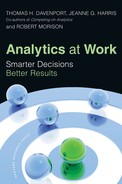Part Two
To unleash the full power of business analytics and sustain it over time, you have to make it part of how people across the organization work, manage, and think every day. Many stage 4 or 5 companies we’ve worked with have the DELTA elements in place, and analytical applications are boosting performance and competitiveness, but only in one or two areas of the business, often marketing and logistics. Meanwhile, the organization at large does not employ analytics, and may be puzzled by what they are and why they matter.
We’re not suggesting that everyone in the company must be analytical, simply that the more analytical amateurs a company has, the merrier. And we’re not suggesting that all business activities need formal models—after all, the purpose of having an enterprise view and targets is to focus resources and efforts where the payback is greatest. We are saying that a company’s operations, decision making, and performance can be improved in countless small ways if more employees know how to find relevant data, analyze it, make sounder decisions, and manage by fact. Analytical thinking should be less the exception and more the rule across the business.
Companies that are truly becoming analytical have three hallmarks:
1. Analytics are embedded in major business processes, the “workhorse” activities of the enterprise. Early decision support systems were intended to help managers report, analyze, and interpret data to make better decisions. But such applications rarely had a significant impact because the tools weren’t integrated with business applications and work processes. Managers who wanted to use them had to interrupt their work to perform an analysis. Embedding is a better approach: design automated processes around repetitive decisions (like auto insurance pricing) that have well-defined criteria. Chapter 7 discusses what kinds of business processes lend themselves to embedding analytics and presents specific techniques for doing so.
2. The company builds and continually reinforces a culture of analytical decisions, a “test and learn” philosophy, and a commitment to fact-based decision making. Managers in analytical cultures are not satisfied with guesses about what works. Merit triumphs over politics, so managers are encouraged to push back when someone proposes a project that lacks data to back it up. In an analytical culture, asking tough questions is the norm, and leadership from the top is critical. As one analytically oriented executive told us, “It is not my job to have all the answers, but it is my job to ask lots of penetrating, disturbing, and occasionally almost offensive questions as part of the analytic process that leads to insight and refinement.” 1 When that kind of attitude spreads through an organization, analytical cultures thrive. Chapter 8 details the characteristics of an analytical culture and how to nourish one.
3. Never satisfied, and always mindful of how business conditions change, the company continually reviews its business assumptions and analytical models. An analytical capability should be no more static than the business world in which it operates. Failure to adapt can be disastrous: consider how U.S. airlines, once pioneers in the use of analytical models for yield management and logistics, lost their competitive edge; or how subprime mortgage providers developed analytical models that worked well when housing prices were rising, only to see the roof cave in when prices fell precipitously. Strategically, you need to review and renew the fit among objectives, business models, and analytical approaches. Tactically, you need to review analytical models. Data sources, emerging technologies, market assumptions and model parameters all need to be reviewed periodically to keep models fresh. Chapter 9 details how to “close the loop” by being clear-eyed and vigilant about managing your use of analytics.
These three characteristics are especially important once you reach stage 3 of your analytical journey. You simply won’t be able to take analytics to the next stage or to sustain analytical momentum across leadership changes unless a critical mass of employees are thinking and working analytically. In sum, these three characteristics distinguish organizations that merely undertake a series of individual analytical projects from those that build a long-term analytical capability, that truly become analytical.
